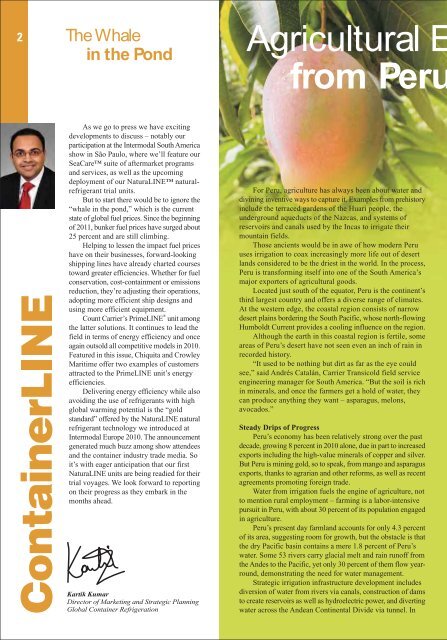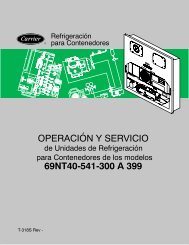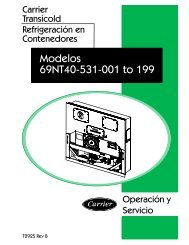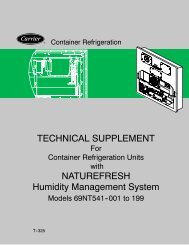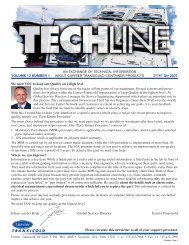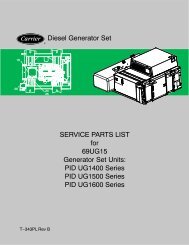Download ContainerLINE April 2011 issue - Carrier Transicold ...
Download ContainerLINE April 2011 issue - Carrier Transicold ...
Download ContainerLINE April 2011 issue - Carrier Transicold ...
You also want an ePaper? Increase the reach of your titles
YUMPU automatically turns print PDFs into web optimized ePapers that Google loves.
The Whale<br />
in the Pond<br />
As we go to press we have exciting<br />
developments to discuss – notably our<br />
participation at the Intermodal South America<br />
show in São Paulo, where we’ll feature our<br />
SeaCare suite of aftermarket programs<br />
and services, as well as the upcoming<br />
deployment of our NaturaLINE naturalrefrigerant<br />
trial units.<br />
But to start there would be to ignore the<br />
“whale in the pond,” which is the current<br />
state of global fuel prices. Since the beginning<br />
of <strong>2011</strong>, bunker fuel prices have surged about<br />
25 percent and are still climbing.<br />
Helping to lessen the impact fuel prices<br />
have on their businesses, forward-looking<br />
shipping lines have already charted courses<br />
toward greater efficiencies. Whether for fuel<br />
conservation, cost-containment or emissions<br />
reduction, they’re adjusting their operations,<br />
adopting more efficient ship designs and<br />
using more efficient equipment.<br />
Count <strong>Carrier</strong>’s PrimeLINE ®<br />
unit among<br />
the latter solutions. It continues to lead the<br />
field in terms of energy efficiency and once<br />
again outsold all competitive models in 2010.<br />
Featured in this <strong>issue</strong>, Chiquita and Crowley<br />
Maritime offer two examples of customers<br />
attracted to the PrimeLINE unit’s energy<br />
efficiencies.<br />
Delivering energy efficiency while also<br />
avoiding the use of refrigerants with high<br />
global warming potential is the “gold<br />
standard” offered by the NaturaLINE natural<br />
refrigerant technology we introduced at<br />
Intermodal Europe 2010. The announcement<br />
generated much buzz among show attendees<br />
and the container industry trade media. So<br />
it’s with eager anticipation that our first<br />
NaturaLINE units are being readied for their<br />
trial voyages. We look forward to reporting<br />
on their progress as they embark in the<br />
months ahead.<br />
Kartik Kumar<br />
Director of Marketing and Strategic Planning<br />
Global Container Refrigeration<br />
Agricultural E<br />
from Peru<br />
For Peru, agriculture has always been about water and<br />
divining inventive ways to capture it. Examples from prehistory<br />
include the terraced gardens of the Huari people, the<br />
underground aqueducts of the Nazcas, and systems of<br />
reservoirs and canals used by the Incas to irrigate their<br />
mountain fields.<br />
Those ancients would be in awe of how modern Peru<br />
uses irrigation to coax increasingly more life out of desert<br />
lands considered to be the driest in the world. In the process,<br />
Peru is transforming itself into one of the South America’s<br />
major exporters of agricultural goods.<br />
Located just south of the equator, Peru is the continent’s<br />
third largest country and offers a diverse range of climates.<br />
At the western edge, the coastal region consists of narrow<br />
desert plains bordering the South Pacific, whose north-flowing<br />
Humboldt Current provides a cooling influence on the region.<br />
Although the earth in this coastal region is fertile, some<br />
areas of Peru’s desert have not seen even an inch of rain in<br />
recorded history.<br />
“It used to be nothing but dirt as far as the eye could<br />
see,” said Andrés Catalán, <strong>Carrier</strong> <strong>Transicold</strong> field service<br />
engineering manager for South America. “But the soil is rich<br />
in minerals, and once the farmers get a hold of water, they<br />
can produce anything they want – asparagus, melons,<br />
avocados.”<br />
Steady Drips of Progress<br />
Peru’s economy has been relatively strong over the past<br />
decade, growing 8 percent in 2010 alone, due in part to increased<br />
exports including the high-value minerals of copper and silver.<br />
But Peru is mining gold, so to speak, from mango and asparagus<br />
exports, thanks to agrarian and other reforms, as well as recent<br />
agreements promoting foreign trade.<br />
Water from irrigation fuels the engine of agriculture, not<br />
to mention rural employment – farming is a labor-intensive<br />
pursuit in Peru, with about 30 percent of its population engaged<br />
in agriculture.<br />
Peru’s present day farmland accounts for only 4.3 percent<br />
of its area, suggesting room for growth, but the obstacle is that<br />
the dry Pacific basin contains a mere 1.8 percent of Peru’s<br />
water. Some 53 rivers carry glacial melt and rain runoff from<br />
the Andes to the Pacific, yet only 30 percent of them flow yearround,<br />
demonstrating the need for water management.<br />
Strategic irrigation infrastructure development includes<br />
diversion of water from rivers via canals, construction of dams<br />
to create reservoirs as well as hydroelectric power, and diverting<br />
water across the Andean Continental Divide via tunnel. In


